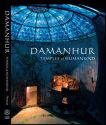
I am building a “tree house” for my daughter, as a present for her forthcoming eighth birthday. (Since there is no actual tree to speak of, the structure will be built on a 12’ X 24’ platform, raised 6’ off the ground.) Of needs, I have been teaching myself basic home construction techniques, while harvesting architectural inspiration from tree house books, Erik Davis’ The Visionary State, and—most recently—Damanhur: Temples of Humankind. A particular twist to tree house construction, which was first suggested to me by my friend Will Beifuss, but then reinforced through reading the Damanhur book, is the inclusion of various secret hiding places. These will be revealed slowly to my daughter, over time, if she doesn’t happen to stumble on them herself in the course of exploring her new nook. The design and construction of physical abodes ties one into a creative energy as old as humanity itself.
Located near Turin, Italy, the Federation of Damanhur is a spiritually based intentional community in the “mystery school” vein, where over 800 men, women, and children focus their existence on the arts, environmental stewardship, and sustainable living. In late summer of 1978, Oberto Airaudi and a group of ten friends first began their work—using only hand tools—digging into the side of a mountain to begin building an amazing collection of sacred spaces: the Temples of Humankind. The work that the early Damanhurians did was kept secret for sixteen years. In 1991, under the ruse of investigating alleged tax evasion, uniformed men with guns and drug-sniffing dogs descended upon the community. The entrance to the Temples remained undiscovered, no charges were ever filed, and no proper explanation for the raid was ever provided. Then again, in 1992, another assault on the community occurred—this time due to an anonymous letter claiming that there were illegally built temples hidden at Damanhur. Armed police threatened to dynamite the mountain if they were not shown the location of the temples. Under such duress, the Damanhurians revealed what they had kept hidden for so long:
An hour later, tearful and overcome by the profound beauty of the Temples, the group [of officials] emerged. The prosecutor put his hand on the shoulder of Damanhur’s founding member, Oberto Airaudi, saying simply, ‘We must do something to save the Temples.’ In Italy, there were no laws to govern or protect such an underground structure, erected without planning or permission.
When news got out that existence of the Temples had been confirmed, the Catholic Church immediately demanded that the government destroy them. Legal battles were fought, international support for the Temples was gained, and ultimately the Italian government changed the laws to legalize past and future construction efforts at Damanhur.
Although Damanhur: Temples of Humankind contains some history of the community, touching briefly on the spiritual ideas of its members, the book is primarily an exposition of the incredible art and architecture that they have created. Damanhurians use widely diverse media to adorn their subterranean structures—painted murals, mosaic tiling, sculpture, and a myriad of stained glasswork constructed in various styles. Secret doorways and hidden passageways are abundant throughout the Temples, and the walls are covered in countless cryptic ideogrammatic messages written in over a dozen ancient texts. The gestalt of their construction is overwhelming—it is amazing that it exists at all, much less that it was created in secret for so long. And according to the Damanhurians, only about ten percent of their planned construction has been completed. An attractive map at the beginning of the book provides a diagrammatic sense of the numerous rooms and chambers, and an excellent job is done throughout the book of explaining the symbolic meanings of the art depicted.
One thing that struck me strongly while immersed in this book was the similarity between the art of the Damanhurians and that of other spiritually inspired visionary artists. At times the work presented reflects the styles of Alex and Allyson Grey (it is obvious why they decided to focus on Damanhur for the first book published by their CoSM Press), Martina Hoffmann, Ernst Fuchs, Paul Laffoley, and Andy Lakey. Although psychedelics are not explicitly discussed as having acted as any sort of influencing factor on the Damanhurians, it is clear—even if they played no part in the inspiration of their art—that the artists of Damanhur are entering into and being inspired by similar mental realms.
As a collection of images conveying the majesty of this community, this book succeeds in spades. The only area where I was left wanting a bit more was in the presentation of the history and philosophical ideas behind the Damanhur community. A more in-depth investigation on those counts can be found in the book Damanhur: The Story of the Extraordinary Italian Artistic and Spiritual Community by Jeff Merrifield.
Readers will appreciate the oversized format of Damanhur: Temples of Humankind, which includes several sections that fold out to reveal even larger panoramic images. The book was designed such that it mirrors the dimensions of Alex Grey’s two coffee-table art books, thusly providing a comfortable indication of where it belongs on the visionary art aficionado’s bookshelf.
Exploring this book is a delight, with jewel-like bursts of color surprising the viewer down every passageway and excavated chamber. Like ineffable experiences of the Godhead, so too the impact of the art and architecture that make up the Temples of Humankind can not be adequately expressed in the words of any review. Quite simply, Damanhur: Temples of Humankind belongs in every entheoart lover’s library.
Foreword by Alex Grey. Introduction by Rob Calef. Poetry by Oberto Airaudi. Edited by Allyson Grey. 2006 (CoSM Press, 542 W. 27th Street, New York, NY 10001, www.cosm.org), ISBN 1-55643-557-0 [13.75” X 10.75” hardback, $50.00], 121 pages, full-color photographs by Roberto Benzi throughout.
Originally Published In : The Entheogen Review, 15(4): 141-2Fatal error: Uncaught TypeError: count(): Argument #1 ($value) must be of type Countable|array, null given in /www/library/review/review.php:699 Stack trace: #0 {main} thrown in /www/library/review/review.php on line 699

